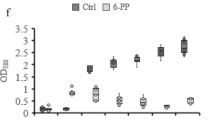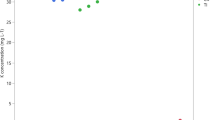Abstract
The increase of soil-borne pathogens induced by phenolic acids that accumulate in continuous cropping soil reduces the yield and quality of crops. The aims of this study were to investigate (i) the biological control of Fusarium solani, in soil enriched with phenolic acids, by the inoculation of the endophytic fungus Phomopsis liquidambari, and (ii) the biocontrol mechanisms involved. Inoculation of P. liquidambari significantly inhibited the reproduction of F. solani. The prompt degradation of soil phenolic acids by P. liquidambari was determined, but no direct antagonism relationship was observed between P. liquidambari and F. solani, implying the alleviated stimulation of phenolic acids was a major factor in controlling F. solani. Moreover, the presence of glucose did not significantly impact the biocontrol function of P. liquidambari, and P. liquidambari inoculation significantly alleviated disease severity of peanut. Therefore, P. liquidambari could be an effective means to control F. solani in phenolic acids-rich continuous cropping soils.




Similar content being viewed by others
References
Blum U (2014) Background for designing laboratory bioassays. In: Blum U (ed) Plant-plant allelopathic interactions II. Springer International, Cham, pp 1–29
Chen LH, Yang XM, Raza W, Li JH, Liu YX, Qiu MH, Shen QR (2011a) Trichoderma harzianum SQR-T037 rapidly degrades allelochemicals in rhizospheres of continuously cropped cucumbers. Appl Microbiol Biotechnol 89:1653–1663
Chen Y, Peng Y, Dai CC, Ju Q (2011b) Biodegradation of 4-hydroxybenzoic acid by Phomopsis liquidambari. Appl Soil Ecol 51:102–110
Chen Y, Wang HW, Li L, Dai CC (2013) The potential application of the endophyte Phomopsis liquidambari to the ecological remediation of long-term cropping soil. Appl Soil Ecol 67:20–26
Cheynier V, Comte G, Davies KM, Lattanzio V, Martens S (2013) Plant phenolics: recent advances on their biosynthesis, genetics, and ecophysiology. Plant Physiol Biochem 72:1–20
Fischer H, Ingwersen J, Kuzyakov Y (2010) Microbial uptake of low-molecular-weight organic substances out-competes sorption in soil. Eur J Soil Sci 61:504–513
Hao WY, Ren LX, Ran W, Shen QR (2010) Allelopathic effects of root exudates from watermelon and rice plants on Fusarium oxysporum f. sp. niveum. Plant Soil 336:485–497
Innocenti G, Roberti R, Piattoni F (2015) Biocontrol ability of Trichoderma harzianum strain T22 against Fusarium wilt disease on water-stressed lettuce plants. BioControl 60:573–581
Jiménez-Fernández D, Montes-Borrego M, Navas-Cortés JA, Jiménez-Díaz RM, Landa BB (2010) Identification and quantification of Fusarium oxysporum in planta and soil by means of an improved specific and quantitative PCR assay. Appl Soil Ecol 46:372–382
Khalifa MMA, Abou-Zeid MY, Fetyan NAH (2013) Performance of fungicides application and Rhizobium inoculation for controlling peanut soil born diseases and their effects on nodulation status and some enzyme activities. J Appl Sci Res 9:2750–2766
Li PD, Wang XX, Li YL, Wang HW, Liang FY, Dai CC (2010a) The contents of phenolic acids in continuous cropping peanut and their allelopathy. Acta Ecol Sin 30:2128–2134
Li ZH, Wang Q, Ruan X, Pan CD, Jiang DA (2010b) Phenolics and plant allelopathy. Molecules 15:8933–8952
Li XG, Wang XX, Dai CC, Zhang TL, Xie XG, Ding CF, Wang HW (2014) Effects of intercropping with Atractylodes lancea and application of bio-organic fertiliser on soil invertebrates, disease control and peanut productivity in continuous peanut cropping field in subtropical China. Agroforest Syst 88:41–52
Ling N, Huang QW, Guo SW, Shen QR (2011) Paenibacillus polymyxa SQR-21 systemically affects root exudates of watermelon to decrease the conidial germination of Fusarium oxysporum f. sp. niveum. Plant Soil 341:485–493
Mandal SM, Chakraborty D, Dey S (2010) Phenolic acids act as signaling molecules in plant-microbe symbioses. Plant Signal Behav 5:359–368
McKeen CD, Wensley RN (1961) Longevity of Fusarium oxysporum in soil tube culture. Science 134:1528–1529
Promputtha I, Hyde KD, McKenzie EHC, Peberdy JF, Lumyong S (2010) Can leaf degrading enzymes provide evidence that endophytic fungi becoming saprobes? Fungal Divers 41:89–99
Rani PU, Pratyusha S (2014) Role of castor plant phenolics on performance of its two herbivores and their impact on egg parasitoid behaviour. BioControl 59:513–524
Rodríguez E, Nuero O, Guillén F, Martínez AT, Martínez MJ (2004) Degradation of phenolic and non-phenolic aromatic pollutants by four Pleurotus species: the role of laccase and versatile peroxidase. Soil Biol Biochem 36:909–916
Rojo FG, Reynoso MM, Ferez M, Chulze SN, Torres AM (2007) Biological control by Trichoderma species of Fusarium solani causing peanut brown root rot under field conditions. Crop Prot 26:549–555
Streibig JC, Olofsdotter M (2002) Joint action of phenolic acid mixtures and its significance in allelopathy research. Physiol Plant 114:422–428
Szanser M, Ilieva-Makulec K, Kajak A, Gorska E, Kusińska A, Kisiel M, Olejniczak I, Russel S, Sieminiak D, Wojewoda D (2011) Impact of litter species diversity on decomposition processes and communities of soil organisms. Soil Biol Biochem 43:9–19
Wachowska U, Głowacka K (2014) Antagonistic interactions between Aureobasidium pullulans and Fusarium culmorum, a fungal pathogen of winter wheat. BioControl 59:635–645
Wang MZ, Chen XN (2005) Obstacle and countermeasure of sustainable high yield for peanut in low-hilly red soil region. J Peanut Sci 34:17–22
Wang HW, Dai CC, Zhu H, Wang XX (2014) Survival of a novel endophytic fungus Phomopsis liquidambari B3 in the indole-contaminated soil detected by real-time PCR and its effects on the indigenous microbial community. Microbiol Res 169:881–887
Wu HS, Wang Y, Bao W, Liu DY, Raza W, Huang QW, Mao ZS, Shen QR (2009) Responses of Fusarium oxysporum f. sp. niveum to exogenously added sinapic acid in vitro. Biol Fert Soils 45:443–447
Wu HS, Luo J, Raza W, Liu YX, Gu M, Chen G, Hu XF, Wang JH, Mao ZS, Shen QR (2010) Effect of exogenously added ferulic acid on in vitro Fusarium oxysporum f. sp. niveum. Sci Hortic 124:448–453
Wu HS, Zhou XD, Shi X, Liu YD, Wang MY, Shang XX, Wu CW (2014) In vitro responses of Fusarium oxysporum f.sp. niveum to phenolic acids in decaying watermelon tissues. Phytochem Lett 8:171–178
Yang B, Wang XM, Ma HY, Yang T, Jia Y, Zhou J, Dai CC (2015) Fungal endophyte Phomopsis liquidambari affects nitrogen transformation processes and related microorganisms in the rice rhizosphere. Front Microbiol 6:982
Ye SF, Yu JQ, Peng YH, Zheng JH, Zou LY (2004) Incidence of Fusarium wilt in Cucumis sativus L. is promoted by cinnamic acid, an autotoxin in root exudates. Plant Soil 263:143–150
Zhang ZY, Pan LP, Li HH (2010) Isolation, identification and characterization of soil microbes which degrade phenolic allelochemicals. J Appl Microbiol 108:1839–1849
Zhang W, Wang HW, Wang XX, Xie XG, Siddikee MA, Xu RS, Dai CC (2016) Enhanced nodulation of peanut when co-inoculated with fungal endophyte Phomopsis liquidambari and Bradyrhizobium. Plant Physiol Biochem 98:1–11
Zhou XG, Wu FZ (2012) p-Coumaric acid influenced cucumber rhizosphere soil microbial communities and the growth of Fusarium oxysporum f. sp. cucumerinum Owen. PLoS ONE 7(10):e48288
Acknowledgements
We are grateful to the National Natural Science Foundation of China (NSFC Nos. 41371290, 41671306), the Special Fund for Agro-scientific Research in the public interest, China (No. 201203050), the GanPo 555 Talents Program of Jiangxi Province, and the Graduate Education Innovation Project of Jiangsu Province (KYZZ15_0215). We also express our great thanks to the reviewers and editorial staff for their time and attention.
Author information
Authors and Affiliations
Corresponding author
Ethics declarations
Conflict of interest
The authors declare that they have no conflict of interest.
Additional information
Handling Editor: Fouad Daayf
Rights and permissions
About this article
Cite this article
Xie, XG., Dai, CC., Li, XG. et al. Reduction of soil-borne pathogen Fusarium solani reproduction in soil enriched with phenolic acids by inoculation of endophytic fungus Phomopsis liquidambari . BioControl 62, 111–123 (2017). https://doi.org/10.1007/s10526-016-9773-9
Received:
Accepted:
Published:
Issue Date:
DOI: https://doi.org/10.1007/s10526-016-9773-9




